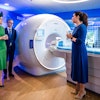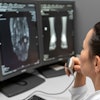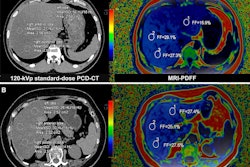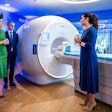The recent FDA approval of Madrigal Pharmaceuticals' Rezdiffra (resmetirom) medication marks a significant milestone in the adoption of medical imaging for identifying and monitoring patients with metabolic dysfunction-associated steatotic liver disease (MASLD) and its more severe progression, metabolic dysfunction-associated steatohepatitis (MASH).
 Rajarshi Banerjee, MD, PhD.
Rajarshi Banerjee, MD, PhD.
For those unfamiliar with steatotic liver disease, this is important because Rezdiffra is the first approved treatment for MASH, which if left untreated can progress to cirrhosis, require liver transplantation, and potentially cause death. MAFLD and MASH are comorbidities for diabetes and obesity with studies estimating that as many as one-third of the population has undiagnosed steatotic liver disease.
During the clinical trials for Rezdiffra (and in many current ongoing clinical trials for MASH) medical imaging played a crucial role in both assessing treatment efficacy and understanding disease progression. Clinical trials for MASH drugs rely on various imaging modalities to provide quantitative and qualitative data regarding liver health, fat content, fibrosis, and inflammation. These imaging techniques not only aid in patient identification and monitoring but also serve as endpoints for evaluating treatment response and overall trial success.
A pivotal role
As Rezdiffra and other therapeutics enter clinical practice, medical imaging will play a pivotal role in the identification and diagnosis of MAFLD and MASH, enabling healthcare professionals to visualize and assess the extent of liver damage. This is because in approving Rezdiffra, the FDA said a liver biopsy was not needed to begin treatment.
Once the standard of care to diagnose steatotic liver disease, liver biopsy is being replaced by new imaging modalities for many reasons including risk to the patient from surgical complications, cost, and accuracy of diagnosis. Advanced imaging techniques contribute to the characterization of tissue microstructure and vascularity, aiding in the evaluation of inflammation and early disease stages. These imaging biomarkers not only inform treatment response but also help researchers identify patients most likely to benefit from specific therapeutic interventions.
Effective monitoring of treatment response is crucial in managing steatotic liver disease, as it allows healthcare providers to adjust therapeutic interventions based on individual patient needs. Given Rezdiffra’s announced annual price of $47,400 per year, payers -- like physicians and patients -- will want to monitor patient response.
Imaging techniques serve as invaluable tools for evaluating treatment efficacy and disease progression over time. For instance, MRI-based proton density fat fraction (PDFF) measurements enable quantitative assessment of hepatic steatosis, facilitating longitudinal monitoring of fat content in the liver. Additionally, other imaging modalities such as magnetic resonance elastography (MRE) provide insights into liver stiffness, aiding in the assessment of fibrosis regression or progression during treatment. By incorporating imaging into treatment regimens, clinicians can potentially enhance treatment response and mitigate disease progression, as evidenced by clinical trials demonstrating improvements in liver fat content and fibrosis markers.
Predicting outcomes, progression
The ability to predict treatment outcomes and disease progression is crucial for optimizing patient care and guiding therapeutic decisions. In MASH, advanced imaging techniques such as diffusion-weighted imaging (DWI) and dynamic contrast-enhanced MRI provide insights into tissue microstructure, perfusion, and inflammation, which are closely associated with MASH’s progression and clinical outcomes. By integrating predictive models and treatment algorithms, healthcare providers can potentially improve prognostic accuracy and identify patients who are most likely to benefit from targeted therapies.
Medical imaging serves as an indispensable tool in clinical trials for MASH drugs in development by providing quantitative assessments of liver fat, fibrosis, and inflammation, and guiding treatment decisions based on objective data. The FDA approval of Madrigal’s compound represents a significant opportunity for the field of medical imaging and its application in diagnosis, treatment monitoring, and prediction of outcomes in patients with MASLD and MASH.
Related cardiometabolic diseases
More broadly, using imaging to identify MASH, track treatment response, and predict patient outcomes also provides the imaging field an opportunity to affirm the clinical use of imaging in related cardiometabolic diseases like obesity and diabetes. In obesity management, for instance, imaging techniques can offer precise measurements of visceral fat, enabling tailored treatment plans and monitoring progress.
Similarly, in diabetes, non-invasive imaging can assess pancreatic health and monitor for complications, revolutionizing patient care. Finally, the use of multiorgan imaging has the potential to identify the impact of systemic disease on multiple organs concurrently, helping providers triage care and shorten a patient’s diagnostic journey.
By combining cutting-edge imaging technologies with targeted pharmacotherapy, healthcare providers have the opportunity to enhance diagnostic accuracy, optimize treatment strategies, and improve long-term prognosis for individuals affected by these debilitating conditions. Beginning with MASH and MAFLD, this paradigm shift catalyzes a new era of personalized medicine, empowering providers to deliver superior care while minimizing patient burden.
As leaders in advancing imaging technology, our industry must lead this transformation and educate providers and payers on imaging’s ability to drive innovation and improve outcomes across diverse disease spectrums.
Rajarshi Banerjee, MD, PhD, is CEO of Perspectum, a developer of image analysis software.



















